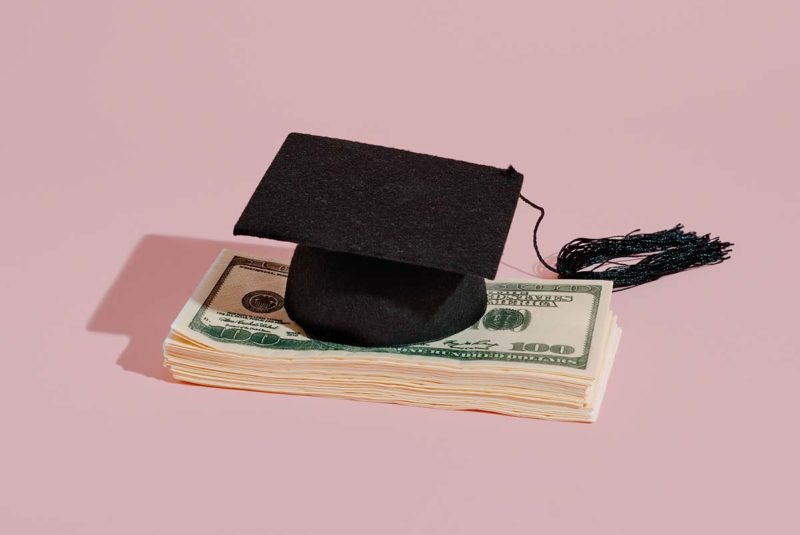When you pay back your student loan, you pay back the amount you borrowed and a little something extra. That little something extra is what’s known as interest. Interest is the fee you pay to borrow money from a lender.
Let’s say you got a loan for $30,000 with a 4.99% fixed interest rate and a 10-year repayment period. After 10 years, you’d end up paying your lender $38,165.99. That’s an extra $8,165.99 in interest. Curious about how we calculated that? You can see how we did it in three easy steps a little further down.
You’ll have to pay interest for both federal and private student loans. How much you pay in interest will depend on the type of loan you get and the type of rate you choose.
How Do Student Loan Interest Rates Work?
Your interest rate is the single most essential factor in calculating how much your student loan will cost you over the life of the loan. So, let’s explore how interest rates work for both federal and private student loans.
Federal student loan interest rates
Federal student loans only come with fixed rates. The rate is “fixed” (think: stays the same) over the life of the loan. Each year, Congress updates the rates for each type of federal student loan. Here are the rates for the 2021 – 2022 academic year[1]:
| Federal Loan Type | Type of Borrower | Fixed Interest Rate |
| Direct Subsidized Loans and Direct Unsubsidized Loans | Undergraduate | 4.99% |
| Direct Unsubsidized Loans | Graduate or working professional | 7.54% |
| Direct PLUS Loans | Parents, graduates or professional students | 6.54% |
Private student loan interest rates
Private student loan lenders offer both fixed-rate and variable-rate loans. A variable interest rate (aka floating or adjustable rate) is the opposite of a fixed rate. A variable rate can “vary” (think: doesn’t stay the same) over the life of a loan.
The interest rates for private student loans are established by individual lenders and based on market conditions and your credit score. To qualify for a private student loan and a good interest rate, you’ll need a credit score of 650 or higher.
BTW, if you have a federal student loan and you want a variable interest rate because rates are low, you’ll have to refinance your loan with a private lender. After refinancing, your loan would no longer be a federal loan, and you would lose the benefits and protections that come with federal student loans.
How To Choose Between Variable and Fixed-Rate Student Loans
If you’re choosing between a fixed and a variable interest rate, you’ll need to understand their differences and weigh the pros and cons.
With a fixed interest rate, your monthly payments stay the same over the loan term. With a variable interest rate, your monthly payments can change over the loan term, depending on how the economy and market are doing.
Pros and cons of a fixed-rate student loan
Sometimes, fixed interest rates are more expensive than variable interest rates in the beginning. However, fixed interest rates are a solid option for lower-income borrowers who can’t afford to make higher monthly payments if interest rates go up.
Pros:
- The interest never changes on a fixed-rate student loan: You’ll know exactly how much you’ll be paying in interest over your loan term, and you’ll be able to decide early on if you can afford those monthly payments. And, because your payments won’t change if and when interest rates go up, a loan with a fixed rate could end up being less expensive in the long term.
- You can estimate your tax benefit (aka tax deduction): Since you’ll know how much you’ll be paying, you can estimate how much of a tax benefit you’ll get in advance by deducting the loan interest.
Cons:
- Your rate won’t lower: A fixed rate stays the same throughout the loan, while a variable rate could lower if market rates decrease.
- Might have a higher initial interest rate: Initially, fixed interest rates are usually higher than variable rates. This means that you’ll spend more on your first few monthly payments. (Variable-rate loans tend to have lower interest rates early on, then they can go up or down, making them a riskier choice for budget-conscious borrowers.)
- Might be expensive for a short loan term: Fixed-rate loans usually make the most financial sense when you plan on paying off the loan over a longer period. A fixed-rate loan over the short term could end up costing you more than a variable-rate loan with a lower interest rate over the same repayment period.
Pros and cons of a variable rate student loan
Variable interest rates are best for borrowers who qualify for the lowest possible interest rates. If you have a short repayment period or plan to make extra payments, you could potentially pay off your debt before any rate increases.
Pros:
- Lower interest rate at the start: If you qualify for a low, variable interest rate, you could end up saving money with a short repayment period.
- Rates may drop: While a variable interest rate can rise, it can drop, too.
Cons:
- Potentially more expensive: If you choose a variable interest rate and it increases at the beginning of your repayment period, there is no guarantee that it’ll drop. And that could end up costing you more.
- Unpredictable repayment plan: If your variable interest rate changes, so will your monthly payments. That can make it hard to estimate how much your student loan will cost you from year to year.
How To Calculate Student Loan Interest
Before you commit to a student loan interest rate type and sign on a dotted line, calculate how much the loan and interest will cost you over its repayment period. Even if you’re not a math person, you can calculate your student loan interest in three easy steps.
Let’s say you borrow $15,000 with a 4% annual interest rate, which you’ll pay back over a 10-year standard repayment plan. In this case, your monthly payment would be about $152.
1. Divide your annual student loan interest rate by the number of days in the year to calculate your daily interest rate.
.04/365 = 0.00011, or 0.011%
2. Multiply your remaining loan balance by your daily interest rate to understand how much interest your loan gains each day.
$15,000 x 0.00011 = $1.65
3. Multiply your daily interest amount by the number of days since your last payment to calculate your monthly interest payment.
$1.65 x 30 = $49.50
Variable and Fixed Interest Rates: Which To Choose?
When deciding what type of interest rate to choose, make your financial situation your top consideration. If you’re refinancing all of your student loan debt and plan to pay it off ahead of schedule, a loan with a variable rate might be the best choice for you. But, if you’ve got a lot of student debt and think you’ll need more time to pay it off, a fixed-rate loan would be a solid option.
The Short Version
- There are two types of student loan interest rates: variable and fixed
- A variable interest rate could cost less in the long run if you have a short repayment period
- A fixed interest rate is a good option for lower-income borrowers who appreciate predictable payments
Federal Student Aid. “Understand how interest is calculated and what fees are associated with your federal student loan.” Retrieved January 2023 from https://studentaid.gov/understand-aid/types/loans/interest-rates




